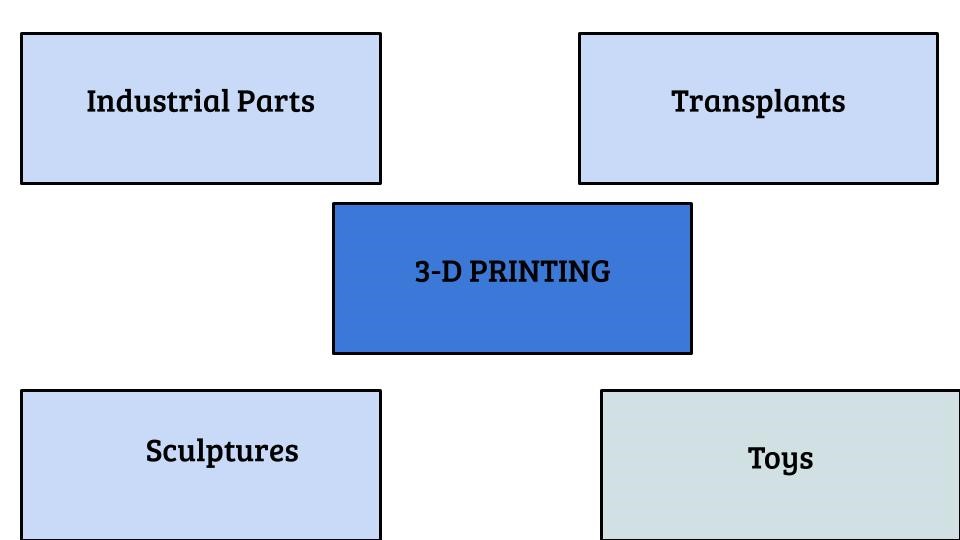
One of the subsets of the evolving automation revolution is the advent of 3-D printing. As a modern marvel, current enthusiasts are raving about the fact that you can 3-D print almost anything that you can think of. Imagine a world, where all you have to do, is download the algorithm for the dimensions of an item of your choice – be it a toy, a new cup for your kitchen, a missing screw, a vase for your bay window, a transplant for your aching knee. Almost anything that you can think of, is printable via a mechanism such as 3-D printing. As with all technologies, there is always an adjustment curve that causes a shift from only small scale access to a technology by large organization to one that everyone can access either in their own home, or via ordering services that will deliver to them.
The History of 3-D Printing
3D Printing as a technology is one that evolved from the late 1980 with the advent of the SLA printer in 1987. At a very high price point, approaching the half a million to $700K USD mark, view individuals and even organizations could afford such a brilliant technology. The cost curve, and entry point for this lovely machine isn’t different from many emerging technologies.
What industries needed to do then, is simply enable themselves to optimize on pricing, and then the demand would increase. Fast forward a few decades, and the price point in the mid 2000’s approached $50K in terms of US Dollars. At a price point that’s equivalent to an SUV, many organizations and individuals did develop the ability to acquire these devices and production of various items is readily available. In current price points and with the advances in technology, a quality product is available for under $2000.
With the evolution in technology, it will be exciting to see that it will now be possible to start utilizing the technology for a variety of reasons. Within the industrial realm the usage of 3-D printing is numerous.
In the Medical Realm:
While minimally invasive procedures usually facilitate a fast turnaround time, there may be instances where detailed and reconstructive procedures will be the optimum path for recovery. Technological breakthroughs are taking place at faster rates than ever. Orthopaedic surgery, is no stranger to 3-D printing as an emerging option that individuals can take advantage of. In instances of fragmented bones, or degenerated bones due to conditions such as Charcot foot, the bones can actually be re-built.
The body heals in a particular way after a trauma, which is at a slower rate than many organisms which have the ability to regenerate quickly. Therefore humans need a little help to facilitate healing. Bones in particular, take up to three months to heal, and in some instances such as war induced limb fractures, shattered bone replacement is a challenge that often leads to limb amputation.
With the advent of technologies such as material science and 3-D printing, it is now possible for scientists, biomedical engineers and orthopaedic surgeons to pool together in order to reconstruct limbs in a manner that is akin to the original joint orientation that exists.
In the Industrial Realm:
Design of various items that we utilize on a daily basis, is now being facilitated by 3-D printing. In the design of chairs for instance, there have been instances where designers have utilized 3-D printers to facilitate the design and printing of prototypes for use in various aspects of life. Chairs that are of a solid plastic, which were previously manufactured via processes like thermoplastic moulding, can now be 3-D printed.
As the world continues to evolve, the possibilities of utilizing 3D printing is expanding and growing. University business development hubs, are now ensuring that they have 3-D printers available for use by their future entrepreneurs and researchers. There will never be a shortage of the need for good entrepreneurs, who can take their skills, see what can be, and mould a platform that will deliver quality products and services to the world.
Current Advantages of 3-D Printing
The Amazon.com revolution has facilitated access to items at an accelerated pace via the advent of delivery systems such as their Amazon Prime service, and also via the drone delivery system. With 3-D printing, the items will be manufactured in your home, and all you will have to do is collect them once they are finished, and ensure that your printer is serviced and has the appropriate feed stock on hand for your desired items. The ability to have something now, or quickly is one of the advantages that 3-D printing will bring to the table. With the convenience factor at play, many individuals want the ability to be able to access.
From an industrial perspective, it will be a brilliant idea to create prototypes on site for various products. In the instance where critical parts such as specialty screws are needed, having the ability to print your own tools will be one that will be well warranted by the organization. As the technology evolves, entire industries are seeking ways to optimize their operational systems via 3-D technology. The time is now, for advances in the area. For Operational Excellence, this is a tool that will facilitate the optimization and customization of critical jobs.
